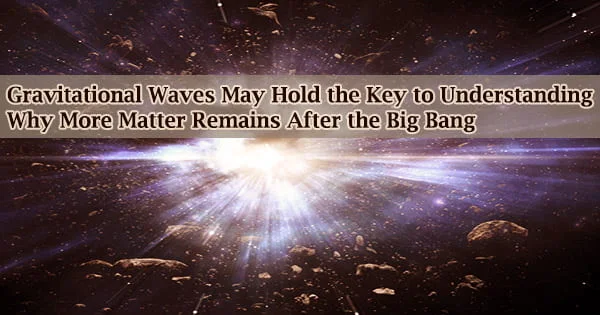According to a new study published in Physical Review Letters, a team of theoretical researchers discovered it would be able to detect Q-balls in gravitational waves, and their finding would explain why more matter than anti-matter was left over after the Big Bang. Humans exist because more matter was formed than anti-matter at some point during the first second of the Universe’s existence.
The asymmetry is so slight that for ten billion anti-matter particles produced, only one extra particle of matter is produced. The problem is that, despite its modest size, current physics theories are unable to explain it.
In fact, normal theories suggest that matter and anti matter should have been formed in exactly equal amounts, but the existence of humanity, the Earth, and everything else in the cosmos implies that there must be more, undiscovered physics.
Researchers currently believe that this asymmetry was created shortly after inflation, a period in the early cosmos when the universe expanded rapidly. This asymmetry could have been created by a blob of field stretching out across the horizon evolving and fragmenting in just the correct way.
However, even with the world’s largest particle accelerators, directly verifying this paradigm has been challenging because the energy necessary is billions to trillions of times greater than anything humans can produce on Earth.
A Higgs particle exists when the Higgs field is excited. But the Higgs field can do other things, like form a lump. If you have a field that is very like the Higgs field but it has some sort of charge not an electric charge, but some sort of charge then one lump has the charge as one particle. Since charge can’t just disappear, the field has to decide whether to be in particles or lumps. If it is lower energy to be in lumps than particles, then the field will do that. A bunch of lumps coagulating together will make a Q-ball.
Graham White
Now, a group of researchers from Japan and the United States, led by Kavli Institute for the Physics and Mathematics of the Universe Project Researcher Graham White and Visiting Senior Scientist Alexander Kusenko, who is also a Professor of Physics and Astronomy at UCLA, has discovered a new way to test this theory using Q-balls, which are blobs of field.
According to Graham White, principal author and Project Researcher at Kavli IPMU, the nature of Q-balls is a little difficult to grasp, but they are bosons like the Higgs boson.
“A Higgs particle exists when the Higgs field is excited. But the Higgs field can do other things, like form a lump. If you have a field that is very like the Higgs field but it has some sort of charge not an electric charge, but some sort of charge then one lump has the charge as one particle. Since charge can’t just disappear, the field has to decide whether to be in particles or lumps. If it is lower energy to be in lumps than particles, then the field will do that. A bunch of lumps coagulating together will make a Q-ball.”
“We argue that very often these blobs of field known as Q-balls stick around for some time. These Q-balls dilute slower than the background soup of radiation as the Universe expands until, eventually, most of the energy in the Universe is in these blobs. In the meantime, slight fluctuations in the density of the soup of radiation start to grow when these blobs dominate. When the Q-balls decay, their decay is so sudden and rapid that the fluctuations in the plasma become violent soundwaves which leads to spectacular ripples in space and time, known as gravitational waves, that could be detected over the next few decades. The beauty of looking for gravitational waves is that the Universe is completely transparent to gravitational waves all the way back to the beginning,” said White.
The researchers also discovered that the conditions that cause these ripples are relatively common, and that the gravitational waves that follow are large enough and have a low enough frequency to be caught by traditional gravitational wave detectors.
“If this is how the asymmetry was made, it is almost certain that we will soon detect a signal from the beginning of time confirming this theory on why we, and the rest of the world of matter, exist at all,” said White.





